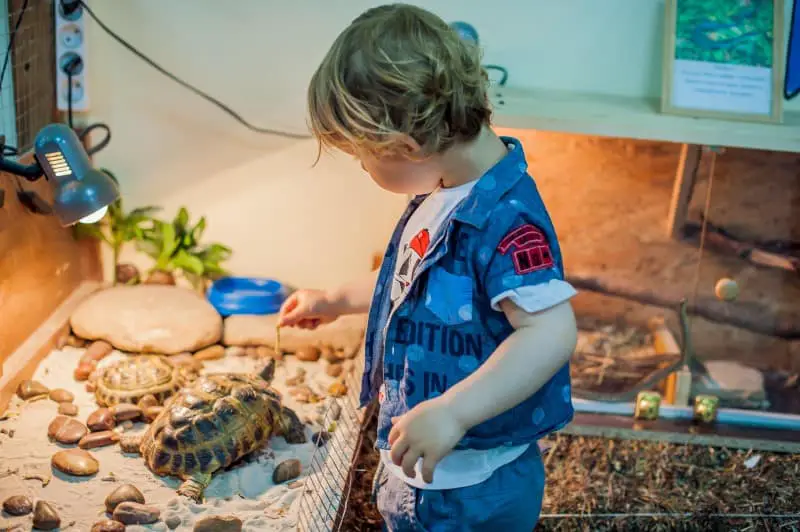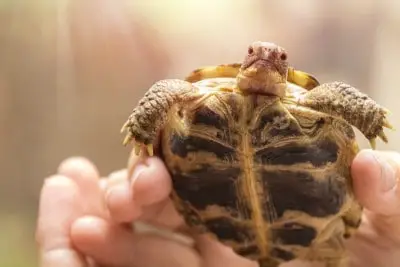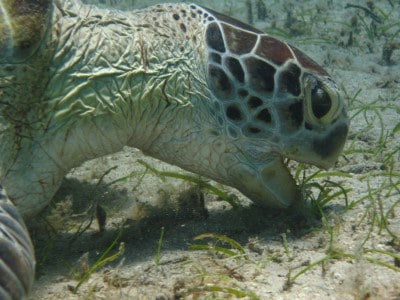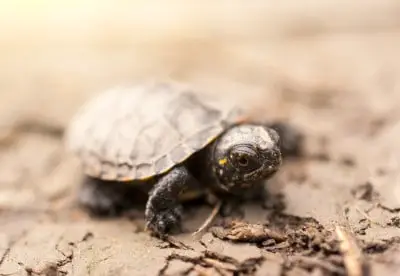Everybody considers their family’s safety first before making the permanent decision to bring in a pet; therefore, many would look for an alternative if the said animal is a health hazard. Tortoises and turtles are great for families, but there are certain rules to follow. We investigated all the possible dangers they can bring to you and your loved ones and how you can go about it.
Tortoises and turtles are great pets. However, they pose a grave danger to infants, toddlers, pregnant women, and the elderly because they are known to host the deadly salmonella bacteria, which transmits to humans and other pets.
Considering members of the group at risk are more vulnerable due to their suppressed immunity, you need to keep them far from children’s reach and sensitize the vulnerable adults about the effects of handling them. Read on for more facts you should know about tortoises and turtles before you introduce them to your family.

Are Tortoises and Turtles Safe Pets for Babies?
Infants are delicate and suffer the most when it comes to dangerous pets. You cannot tell them to stay away or explain what they should or should not do when it comes to safety. It is risky to have a tortoise near a newborn or an infant. Having them near a baby is risky since it may cause salmonella poisoning. There is no way to warn babies not to go near them since their curiosity may run wild, and they may find the crawling animals fascinating to touch and carry.
Once they reach the oral stage, everything they touch goes into their mouth, including tortoises! Contact between the reptile’s skin and the tongue is a direct way to ingest the harmful bacteria that linger on the body. Tortoises are known to host the Salmonella bacteria on their bodies, which are harmful to humans. As a result, medics strongly advise you to wash your hand thoroughly after touching them. Infants may not observe this rule and will touch the reptile and unknowingly bring their hands to their mouths.
Such contact with tortoises or turtles will surely put your baby at risk of salmonella. Consequently, your infant will be sick, and without timely treatment, the results may be fatal. Babies’ immune system is low, and, any minor infection, let alone a severe one like salmonella, can take a toll on them. Additionally, tortoises can’t bite humans, but they have bites strong enough to sever a toddler’s finger. You wouldn’t want them to come near your child.
On the other hand, babies can be fatal to young tortoises too. They tend to grab, flip over and drop them, thinking they are toys. Doing this causes serious damage to the tortoise’s shell, and, if severe, the tortoise can succumb to the injuries unless they get medical attention.
However, some tortoise owners find a way to keep the reptiles with infants in the same household successfully. First, you can place them in a lockable enclosure, far from their reach. Secondly, if your children want to interact with them, you can handle them while they watch at a distance. To be safe, ensure that babies and tortoises or turtles do not interact in any way.
Are Tortoises and Turtles Safe Pets for Toddlers and Children?
Undoubtedly, tortoises and Turtles can make great first pets for kids since they are fun and easy to maintain. Experts find them one of the best options for children’s growth and development. The more time they spend with tortoises and Turtles, the more they learn about responsibility and improve their cognitive abilities. On the contrary, contact with tortoises and turtles can put your children in grave danger. Similarly, the children can endanger the reptiles’ lives.
Therefore, we discourage interactions between the two parties due to concerns about bacterial infections. Young children in particular are at risk due to their developing immunity; their bodies may not effectively fight salmonella infections. It is also tasking to maintain hygiene among toddlers. They may not comprehend the importance of frequent handwashing and may even forget to do it. You have to remind them constantly, but, if you are not around, they may forget.
Secondly, the young ones can’t help being adventurous. You may find them licking, kissing, or trying to eat the tortoise or turtle. Such behaviors lead to acute illnesses, and, in extreme cases, death. It is advisable to limit direct contact. If they must touch it, ensure that they wash up with soap and water afterward. Also, encourage the practice whenever they touch any of the tortoise’s belongings, including the water bowls and the table or enclosure.
Toddlers are known to be rough in everything they do. Thus, they tend to mishandle the tortoises or turtles when left alone with them. Unless you constantly remind them of how best to pet the tortoises or turtle, you will be risking the tortoise’s or turtle’s life by leaving it in their hands. Notably, the tortoise or turtle may get frightened due to the rough handling and may bite to defend themselves. The aftermath will be bite marks, scratches, or serious injuries, but this rarely happens.
You may wonder, what about older kids? Are they safe with tortoises and turtles? Fortunately, the older the children, the better the chances of understanding hygiene and safety. If your child can grasp the essence of sanitation and proper pet handling, they can be safe with tortoises or turtles. Provided they know the gravity of salmonella infections, you can allow them to care for them occasionally. Constantly remind them when they forget and devise creative means like reward systems whenever they remember.
Are Tortoises and Turtles Safe Pets for Pregnant Women?
Like infants, pregnant women are delicate due to their lowered immunity. They have to be safe at all times since anything that happens directly affects the unborn child. If the tortoises or turtles are a health hazard, it is wise for mother and child to keep away to avoid contracting infections. If not, acute complications will arise, which may lead to death.
Pregnant women should not pet or stay near tortoises and turtles. If the reptiles are infected with the salmonella bacteria, the woman can easily contract it due to their low immunity. Afterward, they can easily transmit it to their children. If you or another family member is expecting, and you already have a tortoise or turtle, you need to take extra precautions to be safe. Otherwise, if you are contemplating purchasing one, it is best to hold it off for a while until some months after delivery. Note that nursing mums are as vulnerable as pregnant women; hence, they need the same treatment.
Salmonella thrives in humans with low immunity. For instance, if they attack a pregnant woman, it is fatal because her immunity is suppressed, and her medication options are limited. The doctor must approve any medication; or else, she may endanger her baby’s life. Although not all reptiles are sure salmonella hosts, we usually assume that they all are to sensitize owners about proper sanitation.
When a pregnant woman contracts the infections, it may be mild or lead to dire illnesses depending on the attacked individual. The outcome ranges from digestive issues to miscarriages. The baby needs the mother for growth and development, and, if the illness interferes with her appetite, the fetus will suffer immensely. In extreme cases, the infections transmit to her blood, leading to sepsis, a major cause of premature births and miscarriages.
If you already have a pet tortoise or turtle, there is no need to panic because there are workable solutions to keep both child and mother safe. First, she should never clean the tortoise’s or turtle’s droppings or enclosure since they are bacteria hotbeds. Next, she must stay away from the reptile’s toys, dishes, or anything it frequently contacts.
To be certain, the two should never cross paths, keep the pet in a separate out-of-bounds room if it lives indoors, or keep it permanently outside during the entire pregnancy period. Lastly, other family members should religiously sanitize whenever they contact her, as the illness can transfer between humans.
Are Tortoises and Turtles Safe Pets for the Elderly?
The elderly love tortoises and turtles. They are docile and friendly, just the right energy levels that senior citizens can handle. Since most species can live past fifty years, some elderly owners might have had them when they were toddlers. In such cases, it would be unfair to separate the two after bonding over all the years, but, at times, it is necessary.
It is unsafe for the elderly to be around tortoises and turtles. Just like infants, their immunity is weak, which reduces their fighting chances against illnesses and infections. The main concern with the old is their susceptibility to salmonella. Unlike young people, the effects take a heavy toll on them, as their bodies find it challenging to fight back the poisoning. They suffer for longer, and their survival chances significantly reduce when they get infected.
Secondly, some senior citizens have underlying medical issues due to their age. Therefore, combined with other illnesses, it may strain them. It is recommended that they avoid contacting these reptiles at all costs; or else, it may end up fatal. Most importantly, they need to be hygienic when handling the reptiles, assuming that any tortoise or turtle is a salmonella carrier. This way, they will lower the chances of contracting the bacteria. The only challenge is that they may not maintain the hygiene levels since some tend to forget. If you live with them, you can help them with the handling or cleaning up.
Are Tortoises and Turtles Safe With Other Pets?
Every owner attests that their pet tortoise or turtle is easygoing and lives amicably with humans and other household animals. They rarely cause grave harm unless they feel endangered. Other pets’ safety relies on how the two interact and their relative sizes. Large tortoises are a danger to smaller pets, while larger pets threaten small torts. However, the good thing is that these reptiles and mammal pets like dogs and cats are not enemies. Therefore, they can still coexist peacefully.
As an owner, it is crucial to always be on the lookout when your pets interact. Animals are not predictable; one minute, they are happily socializing; the next, they are fighting mercilessly. The underlying dependent factor is their personalities. Generally, solitary pets would rather keep to themselves and avoid unnecessary confrontations. In contrast, other animals are naturally hostile and territorial; hence, fight others when they feel threatened.
Before you decide to have your reptile live permanently with other common mammal pets, you need to be wary of any eventualities. They may fight, bite or scare each other, making both their lives stressful. Secondly, pets tend to transfer diseases to each other quickly, and, in these cases, they may transfer salmonella to each other and your family members. Tortoises, for one, are severely affected when they get stressed. Hence, the presence of a frightening and bigger pet may cause health issues and lead to concerns like appetite loss.
There are certain guidelines you need to follow to help your pets get along better and faster. Initially, it is best to give them some time to get acquainted first. Place them in the same space and monitor how they act in each other’s presence. They may be shy or pursue each other depending on their personalities. With time and more planned meetings, they may become friends and even play together.
Secondly, ensure that you are present whenever they interact to help you monitor the process and step in if anything happens. By watching them in their element, you will know how they mingle even when you are not around to know whether you can leave them in each other’s company.
Read more: Can Tortoises Live With Other Pets? (Dogs, Cats, Lizards, Geckos, Other Tortoises)
Can Tortoises and Turtles Give You Salmonella?
Most tortoises and turtles do not carry salmonella, but, for caution, experts encourage people to assume that they all host these deadly bacteria. Tortoises and turtles make great pets, but their greatest downside is their ability to host and transfer these infections. Petting a tortoise doesn’t automatically make you a statistic, but you are at high risk of being infected with salmonella bacteria. Thus, a reptile owner must understand what bacteria and parasites they are exposed to through their pets.
Salmonella is rod-shaped bacteria dangerous to humans and animals. It causes stomach upset, fever, body aches, and other ailments. They are found on the tortoise and turtle’s body parts such as its shell, skin, and gut. Since it thrives in the digestive tract, researchers believe that salmonella is also present in the reptiles’ feces. You might wonder whether the bacteria are acute to the tortoises and turtles. The reptiles, over time, have developed strong immune systems that resist the infection. This way, they are just hosts and transfer it to other animals and humans.
You can contract it by touching your pet’s scutes, bare skin, or droppings. If you don’t thoroughly clean your hands afterward, the germs linger, and you will eventually ingest them when you touch food or bring your hands to your mouth. Once you ingest the bacteria, it takes about three days for the symptoms to start showing. People with lower immune systems, such as the elderly, children, and expectant mothers, are at high risk of infection and dire illnesses unless they get treatment; members of this group can quickly succumb to the infection.
Therefore, it is necessary to understand the signs and symptoms of the infections to act fast before it gets out of hand. Watch out for strong fevers, chills, joint pains, severe stomach ache, and bloody stool. The surest way to combat salmonella is by being keen on personal hygiene and keeping tortoises and turtles far from at-risk individuals.
Religiously wash your hands before and after handling them and avoid touching your face and mouth. In the absence of running water, you can alternatively use antibacterial wipes to disinfect your hands. Lastly, remember to wash your pet and its enclosure, including the toys and dishes.
Also read: Before You Touch a Tortoise: 8 Facts You Should Know (Explained)
Where Do You Keep Tortoises?
Tortoises are pretty good pets for you and your family. They are docile and make good lifetime companions, able to live for decades. Any exotic pet lover would be inclined to keep these creatures as pets. The only disadvantage is that they may pose a grave danger to you and your family because they host the salmonella bacteria, an infection that can be fatal unless treated. Therefore, you should consider safely housing your tortoises away from the reach of children and other at-risk family members.
You can either keep tortoises indoors or outdoors as long as your choice takes your family members’ health into consideration. If your tortoise is an indoor pet, you can dedicate a room or a section entirely to them and keep the place locked to prevent children from accessing it. Lock it up at all times and only open to let the children interact with them under your supervision and guidance. Secondly, you can still build an enclosure for the tortoise in the room to reduce the chances of escaping when you open the door. Remember to clean your hands before touching any surfaces after petting your buddy.
If you can’t provide a room for the reptile due to limited space in your home, you may opt for the safe lockable cages instead, ensuring that the tortoise can’t escape and roam around the house. The housing should be sturdy and stable, not to topple over when your pet is inside. If you are using a tortoise table, make sure it is raised high enough away from children and toddlers’ reach. Avoid erecting your pet’s habitat where there is a lot of traffic, and, instead, place it in a safe open place where you can see what’s happening and who is accessing it.
There are tiny tortoise species that must live indoors, but there are medium and giant tortoises that you can only keep outdoors. With large pets, you can build a nice outdoor enclosure away from your family. Your backyard can be an ideal choice for outdoor housing. Make it lockable and inaccessible to the vulnerable members of your family. Similarly, make sure that the reptile can’t escape the enclosure and interact with other household pets, especially dogs.
Beginners with families are the most disadvantaged because they don’t have enough experience with reptiles. However, every owner must be wary of the danger the reptiles pose hence keep them far from kids and other pets. Also, maintain high hygiene levels and make it a priority for every other family member.
Read more: Best Tortoise Enclosures
Where Do You Keep Turtles?
Turtles and tortoises are members of the same family and make good pets at home. However, there are a few notable distinctions; for instance, turtles are aquatic, thus spend most of their life in water and only come ashore to lay eggs. Freshwater turtles also spend some time on logs when basking. Like tortoises, turtles also harbor salmonella and transmit it to you and other family members, especially children.
Therefore, to keep your family healthy, you should keep the reptile confined far away from individuals susceptible to severe infections. Make a large aquarium that can measure four feet by three or larger enough for your turtles to live comfortably. Aquariums are made of glass, and toddlers can effortlessly break them when they play.
Hence, it is necessary to keep the enclosure raised beyond their reach but ensure that it is stable and can’t fall off. This way, the kids and your pet will be safe. Remember to place the tank in a place with minimal movements to avoid people stumbling upon it.
If you want to keep your turtle indoors, you first need to consider its safety and that of your family. If there is no room, you can still consider an outdoor habitat option. You can dig a small trench, fence it, and provide all the elements that mimic their aquatic life. If you have a large compound, you can house the turtles a few yards from the house to reduce children’s chances of interacting with them. The turtle’s safety also matters; hence, as you take them outdoors, ensure that the aquarium is safe from predators.
Read more: Best Turtle Tanks
Take the Necessary Precaution When Housing a Tortoise or a Turtle
Like any other pet, tortoises and turtles have their merits and demerits. Although they are brilliant, they still pose threats, such as spreading the salmonella virus. However, this should not bar you from owning one. The infection is manageable with proper hygiene and limited direct contact. Therefore, you and your family need to be more cautious, especially for the vulnerable groups, which include children, expectant mothers, or the elderly.
More tortoise facts here:








